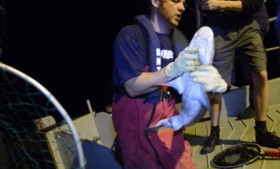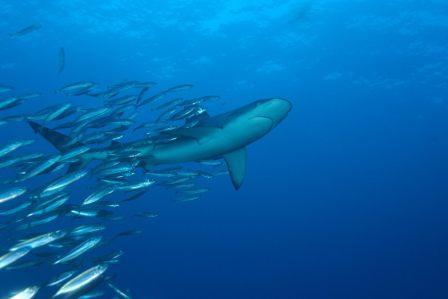Kermadecs Islands: Dolphin Chasing, Whale Watching and Wrestling the Galapagos Shark

Today, we circumnavigated the island in a RHIB, looking for dolphins and hoping for a few whale sightings. There was no sign of the little dolphin pod that greeted us the day we arrived and no whale signs but we’ll keep looking – people on Raoul island have been seeing whales every day.
In the evening, Clinton Duffy was back to fishing for Galapagos sharks (Carcharhinus galapagensis) from the stern ramp of the HMNZS Canterbury. This time he got lucky, and again, it was the Young Blake Expedition students on board who did the fish catching. The biggest of the three Galapagos sharks caught last night was 4 foot (1.2 meters) long and involved a fishing line, a net and a bit of shark wrestling from Clinton.

Galapagos shark in the Kermadecs. Credit: Malcolm Francis.
Once he had the shark on its back on the ramp, his team got to work measuring its length, determining its gender, and clipping off a small piece of the pelvic fin. Then, only a few minutes after it was caught, the shark was released back into the water to carry on its work as top predator.
Clinton has spent a lot of time diving with sharks and observing their behavior – “a shark patrolling the reef, doing its thing, is a thing of absolute beauty,” he says – but on this expedition, he’s after their DNA.
“I’ll use these samples, and others from Norfolk Island, to investigate regional genetic population structure – which should give us an indication of how isolated or connected the Kermadec sharks are to those in similar habitats in the Tasman and Coral Seas.” To complete his project on population genetics, he needs fin samples from 30 of the Kermadecs Galapagos sharks. He has 19 samples from a biodiscovery expedition to the Kermadecs last year, and now three from last night, so only eight to go.
Galapagos sharks are generally found in tropical to subtropical waters around oceanic islands and seamounts. “As far as we know, the Kermadec population is the only New Zealand population of this species,” says Clinton. The range of the adult sharks, which reach 12 feet (3.6 meters) in length, extends far beyond the 12 nautical mile extent of the marine reserve, into areas between the islands where long-line fishing goes on.
“I would like to see the entire archipelago protected,” says Clinton. “It’s likely these Galapagos sharks are moving between the islands.”
This article is repurposed from the Scientific American -original post.
About the Author: Dr Rebecca Priestley is travelling on the HMNZS Canterbury as part of a Sir Peter Blake Trust voyage to the Kermadecs. With degrees in earth sciences and the history and philosophy of science, Rebecca is part of a team of experts selected by Pew Environment Group to join the voyage to this remarkable and remote ocean wilderness two-days sailing northeast of New Zealand’s North Island. Pew is encouraging the New Zealand Government to protect the Kermadec region and the rich biodiversity there by creating one of the world’s largest ocean sanctuaries. Rebecca will working closely with the voyage’s scientists – marine biologists, volcanologists and conservation workers – and will report on the team’s daily adventures and discoveries. While Rebecca has written about the Kermadecs before – you can read her essay about the region’s history and wildlife here – this will be her first visit to the region, and her first long sea voyage. Rebecca’s academic specialty is New Zealand’s nuclear history, but she writes widely about science and science history, including a regular science column for the New Zealand Listener and a personal blog at rebeccapriestley.com, where she wrote about her 2011 trip to Antarctica. She tweets @RKPriestley. Rebecca lives by the ocean in Wellington, New Zealand. Follow on Twitter@RKPriestley.












